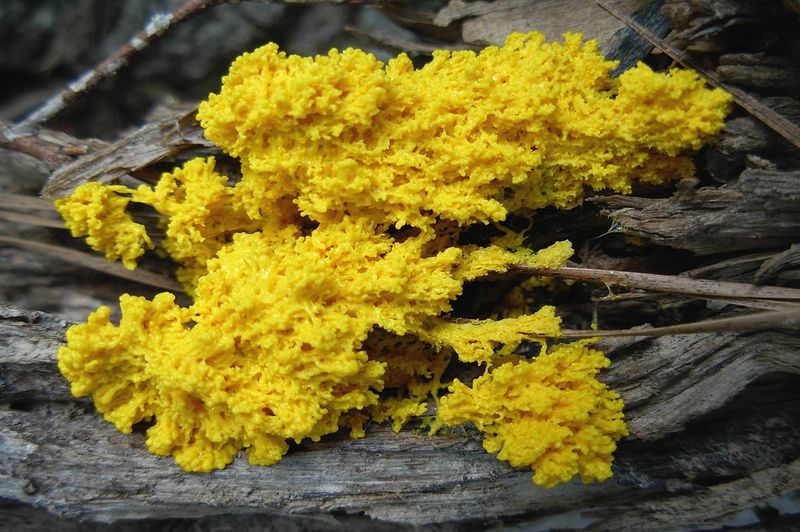Are you looking for ways on how to get rid of yellow slime mold? Even though slime molds rarely cause harm to lawns, their appearance is unpleasant to homeowners.
Learn about the symptoms, the underlying reason, and how to control them.

Slime molds are abundant on all warm and cool-season grasses, which can be challenging to detect. They are most widespread after extended periods of moisture stress, which encourages the growth of slime molds.
Slime molds, however, can cause households great concern when they suddenly sprout on their manicured lawns in crusty, gray to dark fruiting bodies. The emergence of slime mold might cause homeowners to worry about the condition of their properties.
What Is A Yellow Slime Mold?
Yellow slime mold is a brilliant yellow (although it can also appear in various hues such as brown, pink, or white) and slimy substance that is typically found on mulched garden beds during summer months. You can also find it in the mulch that surrounds plants and shrubs.
You may expect that the yellow glob will ultimately turn gray, harden, and eventually decompose into a brown powdered material.
Slime mold is a type that grows and feeds on organic matter that has died or decayed. It is usually harmless, poses little danger to pets, and necessitates no medical intervention in most cases.
The only instance in which this fungus has caused damage to plants is when it has grown over tiny plants and smothered them.
You can also see fungus developing on rough surfaces that have remained wet. Here’s an additional guide on how to get rid of slime mold quickly.
How Do You Kill Yellow Slime Mold?
Slime mold will eventually vanish if left alone. However, you may want to remove it immediately because of its unsightly look.
There are currently no solutions available on the market to help you handle slime mold that develops on your compost. The following are examples of manual removal methods:
1. Apple cider vinegar
It is possible to use apple cider vinegar in a moderate cleaning solution to destroy mold and sanitize the surrounding area. Fill a spray container halfway with equal parts white vinegar and water and shake well.
Using a spray bottle, apply the mixture to the affected region. Spraying wood chips requires stirring the wood chips and spreading a thick layer if this is the case.
If required, repeat this procedure to ensure that mold does not reappear.
2. Tea tree oil
You can also use tea tree oil to destroy slime mold without causing any harm to the surrounding environment. You should fill a spray bottle with two cups of water and two tablespoons of tea tree oil with the solution.
Sprinkle the solution on the region that needs attention. Repeat this procedure every day until the slime mold is gone.
To keep mold at bay, spray the area every two weeks.
3. Baking soda
Using baking soda to cure and avoid slime mold growth is another option. Spritz baking soda on the area where the problem occurred.
Every day, repeat this procedure till the slime mold is completely gone. The slime mold will not reappear if you repeat this procedure every one to two weeks.
It is common to see clumps of jelly-like slime mold developing on lawn grass. Typically yellow or gray in hue, slime molds turn darker as they age and grow larger.
Slime molds usually only live for one to two weeks when they start producing spores. Here’s a home care guide on how long mold spores stay in the air.
How to control yellow slime mold?
Because slime mold bumps usually go away in two to three days, it is not necessary to take any measures to prevent them. Even so, if the growth is unattractive, slime mold pustules can be eradicated by scrubbing away the liquid.
As a technique of eliminating the slime mold’s rigid fruiting bodies, you can use mowing or mild raking. You may get rid of slime mold by spraying your lawn hard with water, which will help break up the slime mold.
When a lawn has been excessively thatched or improperly drained, slime molds may be more likely to appear in the affected regions. A further way to lessen slime mold’s impact is through selective overhead tree cutting.
We do not recommend the use of fungicides to control slime molds on residential lawns. You can treat commercial turfgrass with fungicides, but only if the disease is severe enough to warrant treatment.
How to avoid yellow slime mold?
Try to reduce the quantity of moisture in that region by minimizing watering or raking apart the leaves to promote airflow in that area to prevent the growth of slime molds. With a shovel, you may scoop it out of the way and toss it in the garbage.
Conclusion
Apart from knowing how to get rid of yellow slime mold, it is beneficial to keep an eye on how much water you use in your garden to avoid encouraging all of these unwanted growths.
